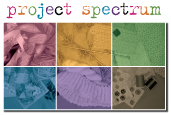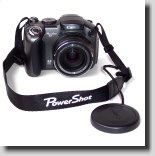
The collection grows. I keep thinking of more shapes that I would like to use in future projects and adding them to my little box.

Angelina Colorform Collection
As I looked at the orange triangles, I thought about what cute fish they would make, so fish they became! Angelina really lends itself to ocean scenes owing to its luminosity. This project takes on a different look from every angle as the various fibers catch the light.
You will find the digitized triangle file in the Fem-Gratis box on the left sidebar. Of course, you can make the shapes without the aide of an embroidery machine.
First, I chose three water fabrics and cut them with wavy edges. I then arranged the Angelina scraps to see how I liked the basic composition.

Water Fabrics and Angelina Scraps
Next, I cut a piece of chiffon on the bias and layered it in the center. I then placed some dark green and light blue tulle (cut with wavy edges) over the entire piece. If you look closely at the introductory picture above, you can see the various shading effects that this produced.

Chiffon, Angelina, and Tulle Layers
When I was happy with the placements, I used a little temporary spray adhesive (505) on the backs of the different pieces and repositioned them.Using 35 weight cotton thread (Valdani Mediterrana), I free motion quilted the water areas.

Free Motion Water Quilting
I then switched to Valdani Midnight Sea and stitched small round loops on the ocean bottom, creating the look of seaweed.

Free Motion Stitched Seaweed
With the same color, I thread painted a few sea plants.

Thread Painted Sea Plants
I tacked the orange triangles down with a dab of fabric glue to keep them in place as I worked.

Tacked Down “Fish” Triangles
The edges were worked with a free motion zig zag stitch using Sulky Holoshimmer thread. When the edges were complete, I worked the fish tails and then the stripes on the bodies. That completed the machine work.

Fish Detail

I chose some metallic colored beads for the eyes and for some of the bead work on the lower reef.

Fish Bead Work
I also used bugle beads on the reef along with a copper star for a star fish.

Reef Bead Work
For bubbles, I applied clear glass beads. And with that, the project was complete.

Glass Bead Bubbles
~~~~~~~~~~~~~~~~~~~~~~~~~~~~~~
Rene
Time Treasured










































